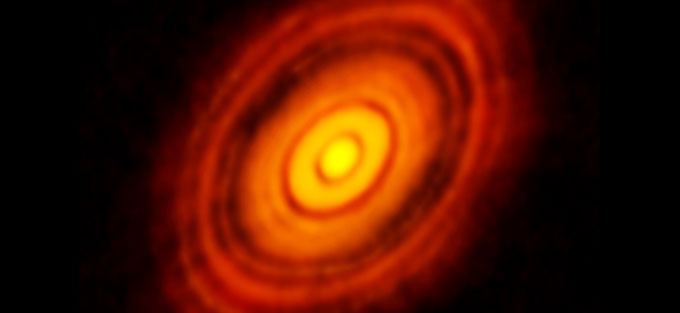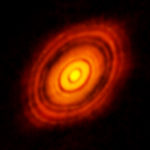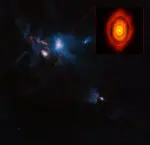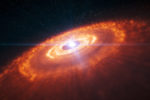Revolutionary ALMA Image Reveals Planetary Genesis
A new image from ALMA, the Atacama Large Millimeter/submillimeter Array, reveals extraordinarily fine detail that has never been seen before in the planet-forming disc around a young star. ALMA’s new high-resolution capabilities were achieved by spacing the antennas up to 15 kilometers apart[1. Since September 2014 ALMA has been observing the Universe using its longest ever baselines, with antennas separated by up to 15 kilometers. This Long Baseline Campaign will continue until 1 December 2014. The baseline is the distance between two of the antennas in the array. As a comparison, other facilities operating at millimeter wavelengths provide antennas separated by no more than two kilometers. The maximum possible ALMA baseline is 16 kilometers. Future observations at shorter wavelengths will achieve even higher image sharpness.]. This new result represents an enormous step forward in the understanding of how protoplanetary discs develop and how planets form.
ALMA has obtained its most detailed image yet showing the structure of the disc around HL Tau[2. The structures are seen with a resolution of just five times the distance from the Sun to the Earth. This corresponds to an angular resolution of about 35 milliarcseconds — better than what is routinely achieved with the NASA/ESA Hubble Space Telescope.], a million-year-old Sun-like star located approximately 450 light-years from Earth in the constellation of Taurus. The image exceeds all expectations and reveals a series of concentric and bright rings, separated by gaps.
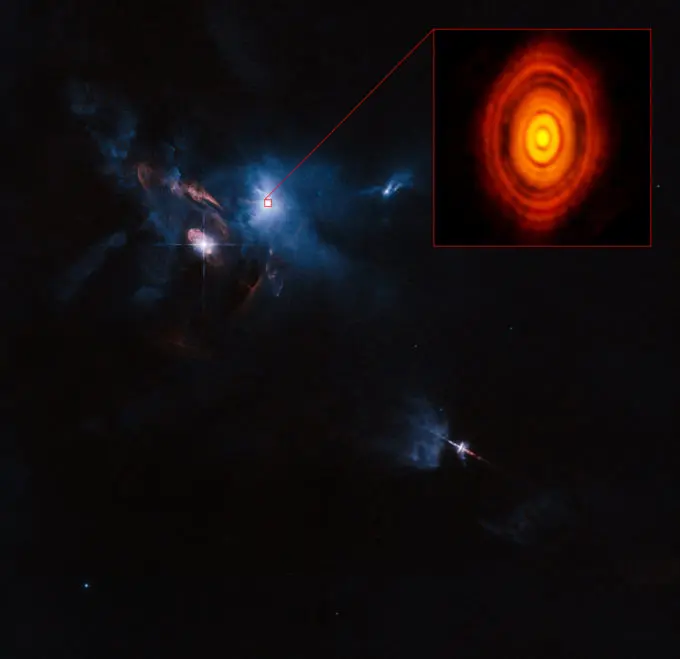
This is the sharpest image ever taken by ALMA — sharper than is routinely achieved in visible light with the NASA/ESA Hubble Space Telescope. It shows the protoplanetary disc surrounding the young star HL Tauri. These new ALMA observations reveal substructures within the disc that have never been seen before and even show the possible positions of planets forming in the dark patches within the system. Credit: ALMA (ESO/NAOJ/NRAO)
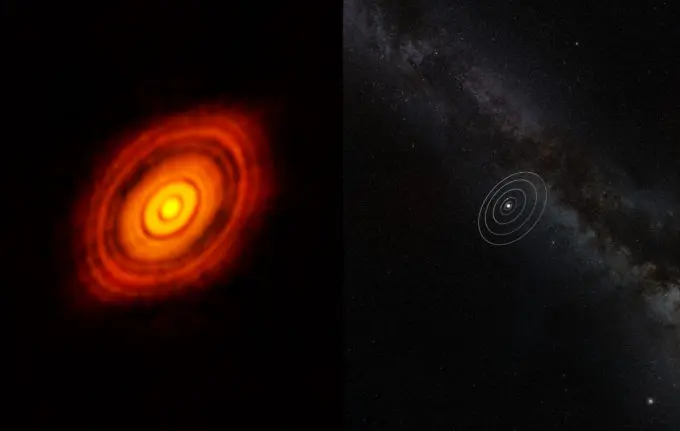
Left: This is a composite image of the young star HL Tauri and its surroundings using data from ALMA (enlarged in box at upper right) and the NASA/ESA Hubble Space Telescope (rest of the picture). This is the first ALMA image where the image sharpness exceeds that normally attained with Hubble. Credit: ALMA (ESO/NAOJ/NRAO)/NASA/ESA
Right: This image compares the size of the Solar System with HL Tauri and its surrounding protoplanetary disc. Although the star is much smaller than the Sun, the disc around HL Tauri stretches out to almost three times as far from the star as Neptune is from the Sun. Credit: ALMA (ESO/NAOJ/NRAO)
"These features are almost certainly the result of young planet-like bodies that are being formed in the disc. This is surprising since such young stars are not expected to have large planetary bodies capable of producing the structures we see in this image," said Stuartt Corder, ALMA Deputy Director.
"When we first saw this image we were astounded at the spectacular level of detail. HL Tauri is no more than a million years old, yet already its disc appears to be full of forming planets. This one image alone will revolutionize theories of planet formation,"explained Catherine Vlahakis, ALMA Deputy Program Scientist and Lead Program Scientist for the ALMA Long Baseline Campaign.
This video shows an artist’s impression of the evolution of the disc around a young star like HL Tauri. From the material in the disc — mostly gas and fine dust — planets begin to form and sweep up surrounding material to create dark patches and ring structures in this disc. Credit: ESO/L. Calçada
Such a resolution can only be achieved with the long baseline capabilities of ALMA and provides astronomers with new information that is impossible to collect with any other facility, even the Hubble Space Telescope. "The logistics and infrastructure required to place antennas at such distant locations required an unprecedented coordinated effort for the international expert team of engineers and scientists" said ALMA Director, Pierre Cox. "These long baselines fulfill one of ALMA’s major objectives and mark an impressive technological, scientific and engineering milestone", celebrated Cox.
Stars like HL Tau and our own Sun form within clouds of gas and dust that collapse under gravity. Over time, the surrounding dust particles stick together, growing into sand, pebbles, and larger-size rocks, which eventually settle into a thin disc where asteroids, comets, and planets form. Once these planetary bodies acquire enough mass, they dramatically reshape the structure of the disc, fashioning rings and gaps as the planets sweep their orbits clear of debris and shepherd dust and gas into tighter and more confined zones.
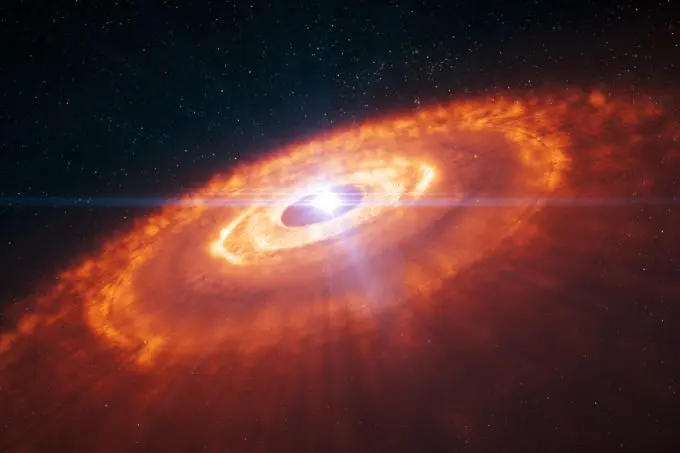
This is an artist’s impression of a young star surrounded by a protoplanetary disc in which planets are forming. Using ALMA’s 15-kilometre baseline astronomers were able to make the first detailed image of a protoplanetary disc, which revealed the complex structure of the disc. Concentric rings of gas, with gaps indicating planet formation, are visible in this artist’s impression and were predicted by computer simulations. Now these structures have been observed by ALMA for the first time. Credit: ESO/L. Calçada
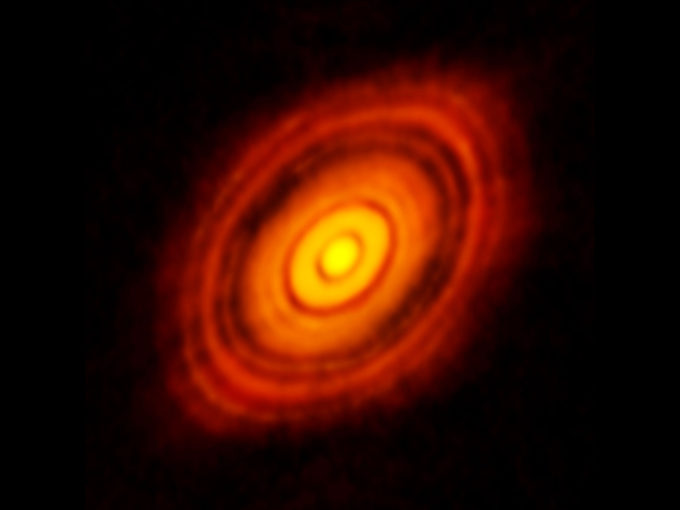
ALMA has obtained its most detailed image yet showing the structure of the disc around HL Tau. It reveals extraordinarily fine detail that has never been seen before in the planet-forming disc around a young star.
Credit: ALMA (NRAO/ESO/NAOJ)
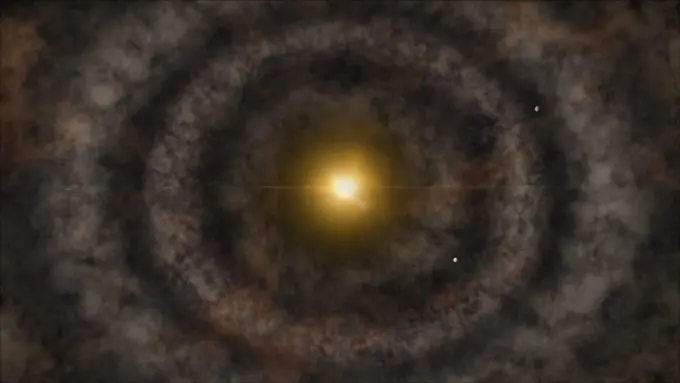
Artist's impression of a protoplanetary disk. Newly formed planets can be seen traveling around the central host star, sweeping their orbits clear of dust and gas. These same ring-link structures were observed recently by ALMA around the young star HL Tau. Credit: National Science Foundation, A. Khan
In the visible, HL Tau is partly obscured by the massive cloud of dust and gas that surrounds it. ALMA operates in such a way that it can see through the cloud and study the processes right at the center. This new ALMA image provides the clearest evidence to date that not only does this process occur, but also that it is faster than previously thought.
The investigation of these protoplanetary discs is essential to our understanding of how Earth formed in the Solar System. Observing the first stages of planet formation around HL Tauri may show us how our own planetary system may have looked more than four billion years ago, when it formed.
This video takes you to the location of HL Tauri in the constellation of Taurus and reveals the astonishing depth and detail that ALMA can now attain. HL Tauri is located at a distance of 450 light-years. The start of the sequence shows a wide view, including the Pleiades and Hyades naked eye star clusters. We then zoom into a very detailed visible-light image from the NASA/ESA Hubble Space Telescope and the final part shows the new ALMA image at millimeter wavelengths. Credit: ALMA (ESO/NAOJ/NRAO)/NASA/ESA/N. Risinger (skysurvey.org). Music: movetwo
This video shows an artist’s three-dimensional impression of the disc around the young star HL Tauri as seen using ALMA. From the material in the disc — mostly gas and fine dust — planets are forming and sweeping up the surrounding material to create dark gaps and ring structures in this disc. Credit: ESO/M. Kornmesser
NRAO Director Tony Beasley discusses the impact of ALMA's new high resolution observations of HL Tau. Credit NRAO/AUI/NSF
Artist's animation of a protoplanetary disk. Newly formed planets can be seen traveling around the central host star, sweeping their orbits clear of dust and gas. These same ring-link structures were observed recently by ALMA around the young star HL Tau. Credit: National Science Foundation, A. Khan
More Information
The Atacama Large Millimeter/submillimeter Array (ALMA), an international astronomy facility, is a partnership of the European Organisation for Astronomical Research in the Southern Hemisphere (ESO), the U.S. National Science Foundation (NSF) and the National Institutes of Natural Sciences (NINS) of Japan in cooperation with the Republic of Chile. ALMA is funded by ESO on behalf of its Member States, by NSF in cooperation with the National Research Council of Canada (NRC) and the Ministry of Science and Technology (MOST) in Taiwan and by NINS in cooperation with the Academia Sinica (AS) in Taiwan and the Korea Astronomy and Space Science Institute (KASI).
ALMA construction and operations are led by ESO on behalf of its Member States; by the National Radio Astronomy Observatory (NRAO), managed by Associated Universities, Inc. (AUI), on behalf of North America; and by the National Astronomical Observatory of Japan (NAOJ) on behalf of East Asia. The Joint ALMA Observatory (JAO) provides the unified leadership and management of the construction, commissioning and operation of ALMA.
Contacts
-
Catherine Vlahakis
-
Valeria Foncea
Education and Public Outreach ManagerJoint ALMA Observatory Santiago - ChilePhone: +56 2 2467 6258Cel: +56 9 7587 1963Email: [email protected] -
Richard Hook
Public Information Officer, ESOGarching bei München, GermanyPhone: +49 89 3200 6655Cel: +49 151 1537 3591Email: [email protected] -
Charles E. Blue
Public Information OfficerNational Radio Astronomy Observatory Charlottesville, Virginia - USAPhone: +1 434 296 0314Cel: +1 202 236 6324Email: [email protected] -
Masaaki Hiramatsu
Education and Public Outreach Officer, NAOJ Chile
